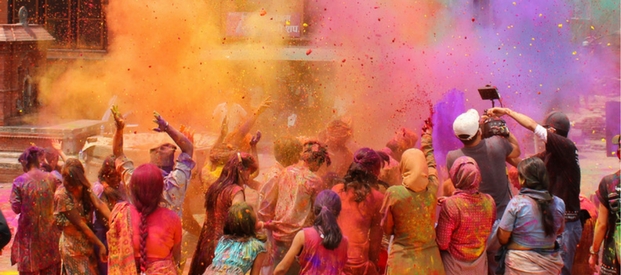Holi, Festival of Colour and Love
This week, despite the snow in the UK, people around the world are celebrating Holi, the Hindu celebration of the end of winter and beginning of spring, in which crowds of revelers are drenched in bright rainbow colours: faces, hands and clothes transformed by the falling clouds of coloured powder.
Holi is celebrated in India, Nepal and many other countries by people of all religions and all ethnicities. It takes place each year at the time of the full moon at the vernal equinox: the first day of the new season on the astronomical calendar. This year it falls on March 1st and 2nd. In recent years, towns and cities in Europe and North America have joined in the fun, although here it is celebrated in the warmer days of summer.
Vishnu or Krishna?
Two different legends explain the origins of this exotic festival; one connected with the god Vishnu and the other with Krishna.
The festival takes its name from Holika, the evil sister of the demon King Hiranyakashyap. The King ordered Holika to walk through fire carrying his son, Prahlada, who had enraged him by worshipping Vishnu. Wicked Holika burned to death while Prahlada, protected by his faith, survived the flames.
According to the second legend, the god Krishna fell in love with goddess Radha but was concerned that she would not love him as his skin was blue. His mother playfully suggested that he should overcome their differences by painting Radha’s face to match his own.
A night and a day
Holi festival lasts for a night and a day, starting with Holika Dahan on the evening before the main celebrations. On this night, friends and relatives gather around a bonfire, sharing favourite foods including popcorn, coconuts, grain and chickpeas roasted on the fire. It’s a celebration of the triumph of good over evil, and in remembrance of the story of Holika, people pray that any evil inside them be destroyed.
The next day is Rangwali Holi when the main event takes place. Large crowds gather in the streets and throw coloured powder in the air and at each other, so that it rains down, covering everyone with streaks of colour. As more and more coloured dye is thrown, the streaks merge and the crowd becomes multi-coloured from head to toe. Lovers paint each other’s faces in matching colours, echoing the story of Krishna and his beloved Radha.
It’s a wild and exhilarating experience, often fuelled by intoxicating drink. Today the coloured powder – gulal – is usually made of synthetic dyes, but traditionally it was made of turmeric, flower extracts and medicinal herbs. The colours are symbolic, with red representing love and fertility and green symbolising spring and new beginnings.
After the revelries, everyone cleans up: experienced participants know that it’s much easier to remove the dye if they moisturise their skin and even oil their hair beforehand. Once they are clean, dressed in their best clothes, people go visiting, celebrating friendship and distributing gifts of traditional sweets.










